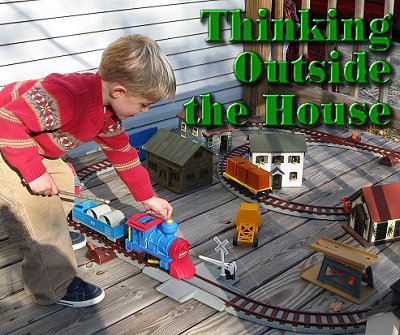 | |||
 |
 |  | |
 |  | ||
 |  | ||
 |  | ||
 |  | ||
 | |||
 |
 |  | |
 |  | ||
 |  | ||
 |  | ||
 |  | ||


Thinking Outside the HouseFor our family, 2010 and most of 2011 have been a blur, with job changes and other urgent responsibilities, so I haven't kept up with my garden railroading "inside" contacts like I'm used to doing. What I've heard in late 2011, however, sounds a lot like what I heard during the economic downturn in 2001-2003. People struggling with economic uncertainty were buying fewer garden trains. As a result, "industry experts" concluded that "fad of garden railroading" has run its course, and it was time for hobby manufacturers to start bailing, or at least putting their R&D money into other hobbies. Yes, the economic downturn IS affecting the hobby, just as the "dot com bubble burst" stalled the hobby's growth ten years ago. Some of you remember those days when:
But, in spite of the naysayers, the hobby rebounded stronger than ever in the years following. Why do folks assume that this economic downturn will deflate the garden railroading hobby for good? Are Any Industry-Specific Forces at Work?As a person who has helped hundreds of families get their trains out of the garage and into the back yard, and who has answered literally thousands of questions, I think I have a bit of insight. I will admit that it's harder to get beginners out in the yard with a shovel and a box of track when home ownership is declining, jobs are scarce, and store shelves are empty (where are the AristoCraft starter sets this year, anyway?). But if there are any hobby-specific forces at work, I have at least one good idea what they might be.The one I'll deal with today is the fact that garden train manufacturers have never really treated garden trains as an oudoor hobby. As an example, after over forty years, we're still using plastic buildings that (except for wall thickness and some UV resistance) could have come from any HO manufacturer. Yes, plastic buildings can be made weather-resistant, and even close to weather-proof (we have a popular article on the subject). But here's a test: the last time you went to the garden supply store and looked at ANYTHING made to go permanently into your back yard, how many items were made of styrene?
Barriers to EntryNearly every day I encounter people who would like to have trains running in the back yard, but don't have the enthusiasm, skills, time, or supportive friends to install an operational garden railroad, even a simple one. Again, we've posted several popular construction articles to make this process as simple as possible. But the focus of those articles is inevitably on building a support system that compensates for the fact that Large Scale track is intrinsically underengineered for out-of-the-box permanent, unsupported, outdoor installation. Yes, thousands of families have overcome those entry barriers, with skills, confidence, hard work, and/or knowledgeable friends. But think about it this way: when you buy a fountain or fake waterfall or canvas gazebo or bench to put in the back yard, you take it home, get it out of the box, and put it in the yard. The gazebo might take two people and a hammer. You don't have to own a post-hole digger or power saw. You don't have to spend days or weeks digging holes, cutting boards, or whatever (depending on which construction method you choose). In short, installing a garden railroad requires a lot of work that wouldn't be necessary if our track didn't need separate support. It's time to think outside of the "Large Scale is HO only bigger" box. Do We Really Need Solid Rails and Plastic Tie Strips?One problem hurting new sales of better-quality garden trains is the cost of brass. The best track has the best brass, and lots of it, because it follows the old LGB standard that your rails should be tough enough to drive elephants over them without damage (as long as the track is on solid ground). In addition, my favorite track also has screw-on rail joiners that make the piece-to-piece connection pretty solid, while the rail joiners are like-new, at least. But even at that, the track is not strong enough to lay on the ground or string between posts indefinitely without some other means of support. Even if it was, it looks funny that way.Couldn't manufacturers use PVC or some other relatively inexpensive material to provide the mechanical strength that outdoor installations really need, while substituting hollow "rails" for expensive solid ones? Indoor scales already have multiple examples of "track" that has an integral sturdy roadbed and less-than-solid rails. It isn't always better looking than solid rails and tie strips, but it's usually sturdier AND less expensive.  
Indoor train examples include Lionel's Fastrack, Bachmann's EZ track, and even Maerklin's old stamped tinplate HO track (not shown). While none of these is structurally sound enough for unsupported use outside, they are all more structurally sound - and less expensive - than equivalent solid-rail-and-tie-strip track. One sort of Large Scale example (though not electrified or made for outdoor use) is the track PlaySkool made to go with their excellent battery-powered trains of 15 years ago (shown in title photo). As silly as it looked to a model-railroader's eyes, when it was set out on the floor somewhere, it really didn't look any sillier than a circle of unballasted rail-and-tie-strips track. Another, more serious Large Scale application was Rocky Chusiano's attempt to provide pre-formed PVC roadbed that could be installed and track-ready in a few hours. Unfortunately Rocky's business (Mainline Enterprises) never made enough money for him to realize "economies of scale." That is, he was forced to cut and machine pieces by hand that a wealthier manufacturer could have molded for a much lower cost over the long haul. Rocky's untimely death, and the fact that the people who tried to keep Mainline Enterprises going faced the same obstacles Rocky did led to the demise of this attempt. But I believe the principles were sound:
What would be wrong with molding the "track" right to the roadbed and doing the same thing? If you're selling track-powered trains, stamp a strip of stainless steel or nickel silver over the top of the "rail" part of the thing like Bachmann does now. Purists will argue that track HAS to have solid I-shaped rails to look realistic, but I would argue that shiny code .332 rails aren't all that realistic anyway. And if solid-rail track increases the cost of the train and makes garden trains harder to install, why do we really need it in every starter set? ConclusionIn an ideal world, a person who wanders into Lowes or Home Depot's garden supply department looking for something new to put in the back yard next summer should be able to see ponds, waterfalls, trees, roses, canvas gazebos, lawn furniture, and garden trains. The person should be able to bring the train and a gazebo home, set up one on Saturday, and set up the other one on Sunday. Why isn't that possible now? Because the track for garden trains isn't really engineered to be used in the garden without additional materials, skills, and hard work.Or, to look at it another way, any beginner can buy an HO train and put it on a train table within a few minutes of getting it out of the box. Any beginner can buy a Lionel train and put it around a Christmas tree just as fast. Why can't "any beginner" set up a garden train in its intended environment almost as quickly? I have some other ideas to change that. I HAVE made inquires and sent suggestions to major manufacturers. I have also tried some "workarounds" that will hopefully become articles in the near future. But I don't have the money it takes to engineer a new family of track products, much less get them into the boxes instead of the expensive, but ultimately impractical stuff we're used to. Maybe going public with these ideas will get SOMEONE with money thinking along these lines. In the meantime, everyone who wants this hobby to continue having a bright future can do their part by holding open railroads, supporting local clubs, helping with display railroads, helping beginners get over their anxiety about digging holes or making 75-degree cuts in 2x6s, or whatever else comes to hand. In other words, get out the news that in these days when economic uncertainty and expensive gasoline is driving folks to "man caves," "backyard rooms," and "staycations," garden trains are ultimately one of the most rewarding home entertainment investments. And when the economy recovers, the hobby should recover as well, unless everybody listens to the same naysayers that predicted the death of the hobby ten years ago. Wishing my friends in the hobby and in the industry the best and brightest times, and hoping you each get some quality time with your family in the coming weeks, I remain, Paul Race P.S. For more information, or to commend or complain about anything in this article, please contact us
|





|

| 
|
 |
 |
 |  |  |
Note: Family Garden Trains?, Garden Train Store?, Big Christmas Trains?, BIG Indoor Trains?, and BIG Train Store? are trademarks of Breakthrough Communications (www.btcomm.com). All information, data, text, and illustrations on this web site are Copyright (c) 1999, 2000, 2001, 2002, 2003, 2004, 2005, 2006, 2007, 2008, 2009, 2010, 2011, 2012 by Paul D. Race. Reuse or republication without prior written permission is specifically
forbidden.
Family Garden Trains is a participant in the Amazon Services LLC Associates Program, an affiliate advertising program designed to provide a means for sites to earn advertising fees by advertising and linking to amazon.com.
For more information, please contact us
